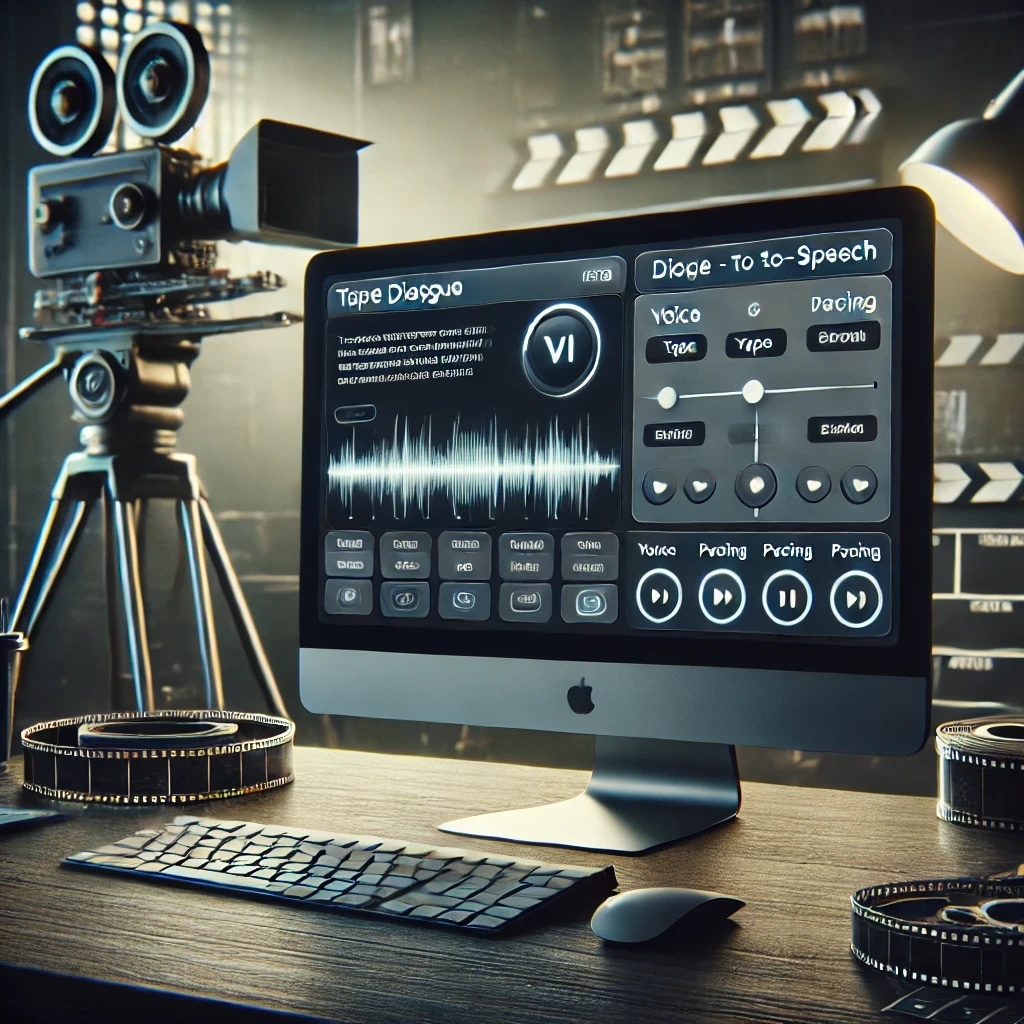
AI tools for filmmakers: next-level dialogue with text to speech
You’ve nailed the visuals, the pacing, the soundtrack. But perfecting the dialogue?
Key takeaways
- AI text-to-speech offers filmmakers quick, flexible voiceover options for high-quality dialogue, saving both time and budget.
- Advanced TTS tools like ElevenLabs allow filmmakers to create expressive, realistic voices for animation, dubbing, and narration.
- TTS makes it easy to add multilingual support and regional accents, enhancing accessibility and global appeal for film projects.
Think back to your latest film project. You’ve nailed the visuals, the pacing, the soundtrack. But perfecting the dialogue? Uh oh, you can hear the wind piercing through the lead character’s soliloquy, that car horn that beeped at exactly the wrong moment, and who yelled that during filming?!
Getting a perfect, crisp dialogue recording is often time-consuming and costly. High-quality voice content can be logistically challenging and tough to adjust mid-project, and in the past, it required extensive refilming, hiring pricey editors, and expensive equipment.
Fortunately, there’s a better way! AI text-to-speech (TTS) technology offers filmmakers a powerful, flexible solution to craft expressive, lifelike dialogue for every project. With options for natural pacing, emotion, and even multilingual voiceovers, TTS makes audio creation both practical and affordable.
In this article, we’ll explore why immersive dialogue matters in film, what makes ElevenLabs’ TTS unique, and how to start creating audio-rich experiences that draw your audience in.
The value of AI in modern filmmaking

What’s changed in filmmaking?
From the Golden Age of cinema, now accessible content is making its way to everyone’s screen. All you need is a good iPhone and a trusty mic, and you, too, can be a YouTube star. The definition of filmmaker has broadened as the costs of entry get lower, but that doesn’t mean that the challenges are different.
Today’s filmmakers are constantly seeking ways to streamline production and maximize creative freedom, all while staying on budget. The rise of AI tools in the industry is just the next step in this process, helping to solve these age old challenges in groundbreaking ways.
TTS technology is a prime example, offering filmmakers an efficient way to produce high-quality dialogue on demand. With the right text-to-speech tool, you can bring characters to life and fine-tune dialogue across a range of projects, from animation and voice dubbing to promotional content and narration. Try Eleven v3, our most expressive text-to-speech model yet.
Here are just a few types of film production that benefit from TTS:
- Voice dubbing and character work: Bring animated or secondary characters to life quickly and experiment with unique voice profiles.
- Narration for trailers and documentaries: Add gravitas to trailers and a professional touch to documentary narration.
- Background character dialogue: Fill in background scenes with clear, realistic voices that add depth without the need for additional actors, and use Voice Cloning to fill in scenes with different dialogue
Practical benefits of AI voices for filmmakers
It’s undeniable that AI text-to-speech provides filmmakers with budget-friendly options and added flexibility that make creative exploration easier than ever. Let’s take a look at a few more ways that AI is revolutionizing the industry.
Probably the most standout benefit of text-to-speech is its ability to streamline production—allowing filmmakers of every size to make quick retakes and adjustments without needing to call back voice actors / rerecord sections / hire new actors. AI gives you the freedom to tweak dialogue on the fly, which is especially useful during fast-paced productions.
Beyond the money and the convenience, AI voiceovers offer flexibility for testing creative options. With the ability to try out various voice profiles, accents, and tones, filmmakers (and those in other industries — hello gamemakers) can explore a wide range of character possibilities and refine each voice to fit perfectly.
Tips for using text-to-speech to perfect film dialogue
So, are you ready to make the most of TTS in your production? Here are our expert tips to get the best results from your AI voiceover for highly immersive dialogue.
Adapt your script for audio
Not all scripts flow naturally in audio form. Choose clear, concise language that translates smoothly to spoken dialogue. Our expert tip? Read your script out loud while writing it to catch any awkward phrasing or overly complex words that may trip up the flow.
Choose your Voice carefully
Think about your audience and your character’s personality to determine the best voice profile. ElevenLabs’ Voice Library includes thousands of voices, so you can explore options and choose the one that aligns best with your character and the tone of your scene.
Adjusting for emotion and cadence
Small adjustments in speed, pitch, and emotion can make a big difference.
In the Voiceover Studio, ElevenLabs allows you to customize voice elements for added nuance, like slowing down for suspense or adding warmth to character dialogue, bringing scenes to life with subtle, impactful changes.
Layering with sound design
Finally, don’t forget to enhance dialogue by blending it with ambient sounds or background audio. Paired with music or sound effects, AI sounds even more immersive, helping the voiceover blend seamlessly into your scene.
(Plus, why not give AI-generated sound effects a try — no more expensive FX studio required)
Other AI tools for filmmakers
In addition to text-to-speech, filmmakers have a growing range of AI tools to streamline production and add creative layers to their work. Here are a few AI solutions worth exploring:
- AI-driven storyboarding: AI-powered tools help you visualize scenes faster, making it easy to plan shots and angles. Think Rivet.AI as an example.
- Visual effects automation: Save time by automating basic visual effects, like tracking or masking, to enhance post-production. We love CapCut for this kind of work.
- AI in editing: Machine learning can match visual cuts to dialogue pacing, making editing efficient and impactful—ideal for fast-paced trailers. Invideo is a good choice for this.
Realistic dialogue on demand with ElevenLabs
But what is the best tool to unlock all of these benefits? The answer is simple: Elevenlabs, of course!
ElevenLabs’ text-to-speech technology stands out in the industry with its advanced neural network, designed to produce voices that feel genuinely human.
Through sophisticated modeling, the geeks behind the AI at ElevenLabs capture the nuances of real speech—allowing filmmakers, gamemakers, YouTubers, and content creators to create lifelike dialogue that feels super natural but that fits a project perfectly.
Give it a listen here:
News
On top of this, ElevenLabs’ multilingual options allow creators to switch between languages and even incorporate regional accents, adding layers of cultural authenticity to scenes. Plus, you can do so much more with audio at ElevenLabs, with tools like sound effects, Voice Design, Voice Isolator, and more.
Final thoughts
With high-quality, AI-driven text-to-speech from ElevenLabs, filmmakers can add lifelike, expressive dialogue to any project. TTS makes dialogue production more accessible and efficient, offering fresh opportunities for filmmakers to explore their vision without sacrificing quality.
If you’re ready to elevate dialogue in your own film projects, it’s time to experiment with text-to-speech. Try ElevenLabs for free and see the difference it can make in your production.

Explore articles by the ElevenLabs team

Lemon Slice launches real-time avatar agents powered by ElevenLabs
Bringing expressive, interactive avatars to life with ElevenLabs Agents Platform

Introducing Versioning for ElevenLabs Agents
Complete visibility into agent configuration changes and safe, staged rollouts of new versions.
